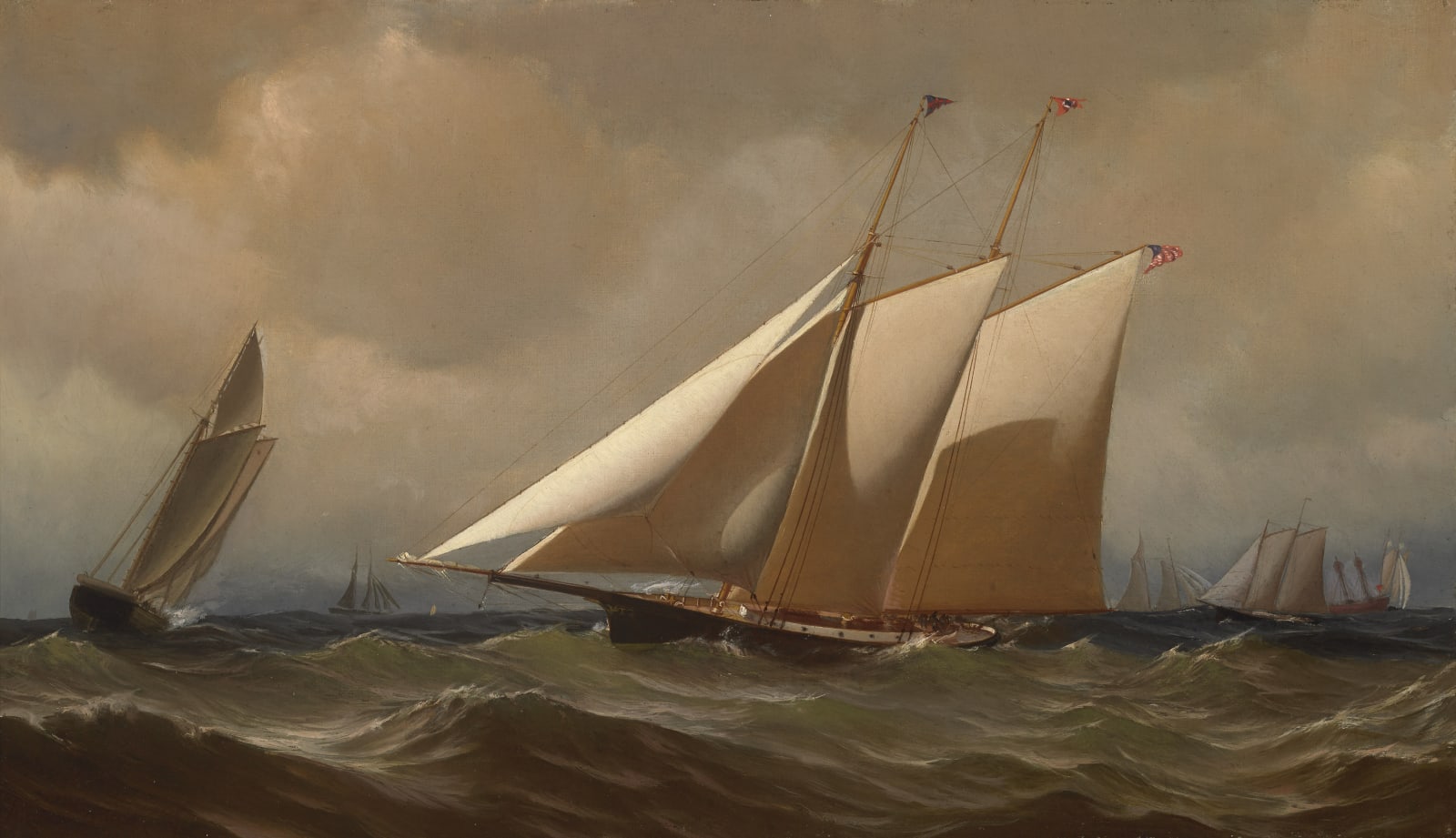Archibald Cary Smith 1837-1911
Racing Yacht "Comet" Off New York, 1879
Oil on canvas
14 x 24 inches
35.6 x 61 cm
Framed dimensions: 24 1/2 x 34 1/2 inches
35.6 x 61 cm
Framed dimensions: 24 1/2 x 34 1/2 inches
Signed lower left: A. Cary Smith 79
In Racing Yacht 'Comet' Off New York, Archibald Cary Smith demonstrates his mastery of painting yachts. The graceful lines of the boats are given great energy as the turbulent water...
In Racing Yacht "Comet" Off New York, Archibald Cary Smith demonstrates his mastery of painting yachts. The graceful lines of the boats are given great energy as the turbulent water rises to meet the vessels. Smith uses the dramatic sky, choppy waves, and strong light to heighten the drama of the already dramatic racing scene. It feels as if the boats are racing against an impending storm as much as they are racing against each other. And while the artist effectively highlights the beauty of the yacht through his use of color and light, he does not forgo capturing the force and power of nature. Smith clearly had as much respect for the ocean as he did for the boats that navigated her waters.
Comet–––one of the most successful racing vessels of its time––-was built by A.E. Smith in 1874 for W.H. Langley. Langley's private signal, which can be seen in the painting flying from the top of the mainmast, was a red swallowtail pennant with a white diamond enclosing a smaller blue diamond. There was a white letter "C" in the center of the blue diamond. The care the artist took with accurately painting these details in many ways speaks to the painting's function as a historical document, or record of a moment in the life of the yacht, as well as an accomplished work of art.
Archibald Cary Smith was born in New York City. He was educated at the University grammar school, and as a young man learned drafting and boat-building skills. In 1863 he studied painting under Maurice F. H. De Haas, a Dutch-born painter who specialized in maritime scenes. During the 1860s Smith exhibited at the National Academy of Design and the Pennsylvania Academy of the Fine Arts.
Smith painted and designed yachts concurrently. In his paintings his technical understanding of boating is evident. The mastery with which he paints the vessels could only come from one who had an intimate understanding of the ways that boats move in water. True to the romantic age in which Smith was painting, his works often incorporate elements of danger. The viewer is always aware of the immensity of the ocean and awesome powers of nature.
Smith’s yacht designs were met with great acclaim. He was responsible for designing the first iron yacht that was built in Chester, Pennsylvania, and it attracted much attention as an interesting and successful departure from the usual type. Eventually, Smith devoted himself entirely to designing and altering yachts of all kinds, including the yacht Mischief, which successfully defended the America’s Cup in 1881. In 1887 Smith delivered a course of lectures on naval architecture for the Seawanhaka yacht club in New York. And for many years he was Measurer of the New York Yacht Club.
Comet–––one of the most successful racing vessels of its time––-was built by A.E. Smith in 1874 for W.H. Langley. Langley's private signal, which can be seen in the painting flying from the top of the mainmast, was a red swallowtail pennant with a white diamond enclosing a smaller blue diamond. There was a white letter "C" in the center of the blue diamond. The care the artist took with accurately painting these details in many ways speaks to the painting's function as a historical document, or record of a moment in the life of the yacht, as well as an accomplished work of art.
Archibald Cary Smith was born in New York City. He was educated at the University grammar school, and as a young man learned drafting and boat-building skills. In 1863 he studied painting under Maurice F. H. De Haas, a Dutch-born painter who specialized in maritime scenes. During the 1860s Smith exhibited at the National Academy of Design and the Pennsylvania Academy of the Fine Arts.
Smith painted and designed yachts concurrently. In his paintings his technical understanding of boating is evident. The mastery with which he paints the vessels could only come from one who had an intimate understanding of the ways that boats move in water. True to the romantic age in which Smith was painting, his works often incorporate elements of danger. The viewer is always aware of the immensity of the ocean and awesome powers of nature.
Smith’s yacht designs were met with great acclaim. He was responsible for designing the first iron yacht that was built in Chester, Pennsylvania, and it attracted much attention as an interesting and successful departure from the usual type. Eventually, Smith devoted himself entirely to designing and altering yachts of all kinds, including the yacht Mischief, which successfully defended the America’s Cup in 1881. In 1887 Smith delivered a course of lectures on naval architecture for the Seawanhaka yacht club in New York. And for many years he was Measurer of the New York Yacht Club.
Provenance
Private collection;McClees Galleries, Haverford, Pennsylvania, 2004;
Avery Galleries, Haverford, Pennsylvania, 2005;
Private collection, Pennsylvania, until 2020
Please join our mailing list
* denotes required fields
We will process the personal data you have supplied in accordance with our privacy policy (available on request). You can unsubscribe or change your preferences at any time by clicking the link in our emails.



